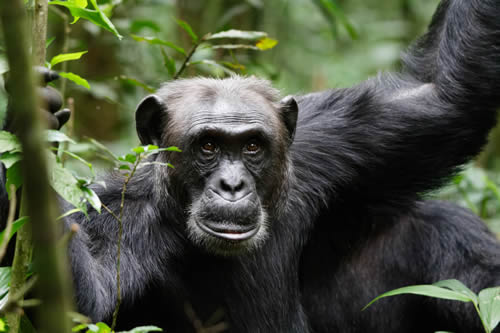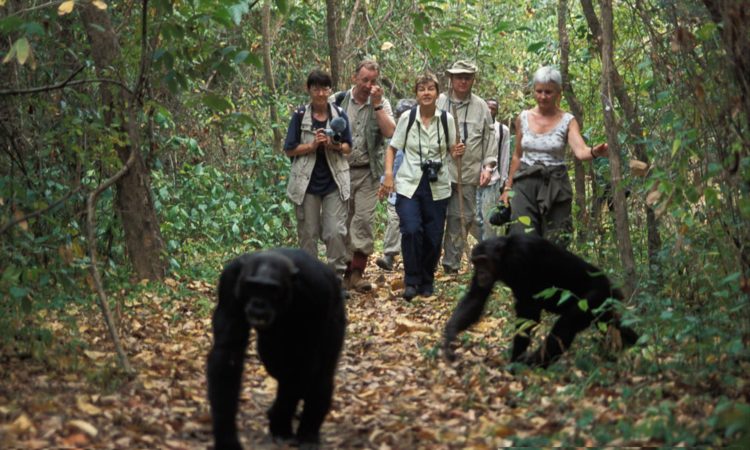A trip to trek with chimps in Rwanda

The country that is known as the ‘Land of a Thousand Hills’ is praised not just for its stunning scenery but also for its lively culture. What sets Rwanda apart, however, is its remarkable wildlife. And of all the once-in-a-lifetime opportunities Rwanda offers to adventure seekers and nature enthusiasts, trekking to see our closest ancestors in the wild is the crème de la crème. This article looks at what is involved in a trip to trek with chimps in Rwanda, from what you will see and hear in the lush forests to the spellbinding characters that the chimpanzees are.
Visitors are introduced to Rwanda’s breathtaking beauty even before they start their chimpanzee treks. The land they traverse to get to the trekking sites is beautiful beyond compare, with rolling hills, terraced farmland, and serene lakes, all set in a lovely green of many shades. Of course, the most popular location for chimp trekking is Nyungwe Forest National Park, with its unspoiled rainforest strongly shaded by a dense canopy. Covering over 1,000 square kilometers, Nyungwe is one of Africa’s oldest rainforests and a biodiversity hotspot, boasting an excellent canopy walkway that puts you in close touch with its unique flora and diverse forms of life.
Chimpanzee trekking process
In Rwanda, a chimpanzee trekking experience usually begins with a briefing at park headquarters. Visitors are educated about the park’s rules and regulations, the importance of conservation, and what to expect during the trek. Because protection is paramount, sturdy hiking boots, long sleeves, and long pants are necessary treks. A light, packable rain jacket is good smart wear. The weather in the rainforest is unpredictable. Groups are usually limited to a small number of participants, ensuring a more intimate experience with the chimpanzees.

When the trek begins, visitors are surrounded by the enchanting forest sounds. The leaves rustle, the many species of birds call to one another, and the distant chimps can be heard whooping—it is an exhilarating auditory experience. The path through the forest is not too well defined, but it is partially cleared. At first, it winds through densely packed understory plants, and tall trees rise up and over the path. The local tour company employs a chief guide who is accompanied by an assistant. Together, they manage the group. Our chief guide has a university degree in primate biology and has many years of experience. He knows the forest inside and out and shares stories with us to help pace the trek and “kill time” as we push through the thick moss covering some quite slippery rocks. Along with the stories, he plays a few Reggie Watts-like games with sounds.
The first sighting of chimpanzees after hiking for one to three hours makes the trek worthwhile. With anticipation electric in the air, the humans watching from the trees can almost sense what the chimps—found foraging for fruits, grooming one another, or playing—are up to. It’s such a tease of a moment. Yes, we’re in the wild, and yes, the behavior we’re seeing is a glimpse into something that makes these creatures so very not human—but only chimps could be doing what they’re doing at that moment…and commanding our rapt attention.
How do chimps live?
Their intelligence and emotional depth are on clear display, as is the family resemblance. Whether visitors are lucky enough to see a mother nurturing her young, chimps engaged in playful antics, or one of the dominant males asserting authority, it’s a watch-the-waves-in-the-ocean experience.
The experience, without a doubt, is a fantastic one. But we cannot allow ourselves to get carried away with it and must instead remember the essential principles of responsible tourism. We are asked to interact with the chimpanzees as little as possible while still enjoying the chance to observe them in a somewhat natural setting. Our guide, Sharon, told us several times what an important and rare opportunity this is, and how we should soak it in because not many people get to do this—and because, if we don’t do it right, tourism could do chimpanzees more harm than good.
Conseration of Chimpanzees
A chimpanzee trek in Rwanda is more than just an adventure. It is a transformative experience that allows one to foster a deep connection with the wildlife of Africa. When adventurers return from tracking the endangered chimps in Nyungwe Forest National Park, they come back as advocates—ambassadors of sorts—for the conservation of these remarkable, ape-like animals. The adventurers come back with a rare kind of wood, a deep sense of wonder and appreciation for the natural world that is so hard to come by in this hyper-digital age. Rwanda is such a prime destination for a trek because of its commitment to conservation, which allows for authentic and impactful experiences.
If you are prepared to set out on this amazing adventure, think about reserving your chimpanzee trekking experience in Rwanda. This country, with its breathtaking vistas, lush biodiversity, and intense devotion to conservation, provides an unmatched chance to engage with the natural world and to behold the magnificence of the animal kingdom. Viewing our closest relatives in the wild offers a window into the very essence of humanity.


